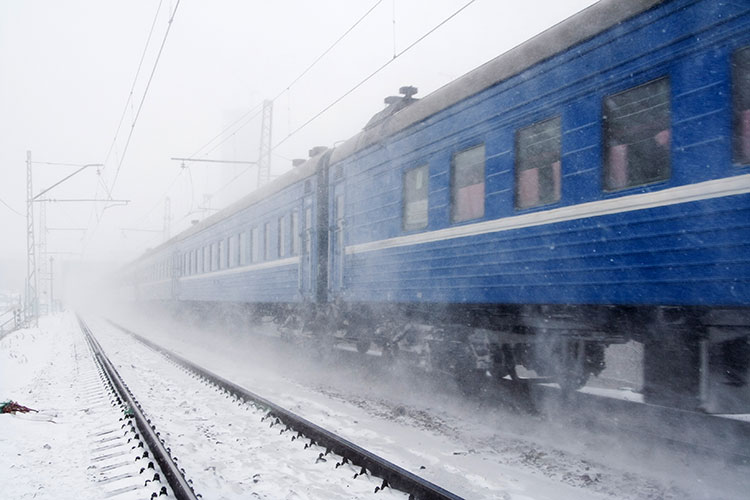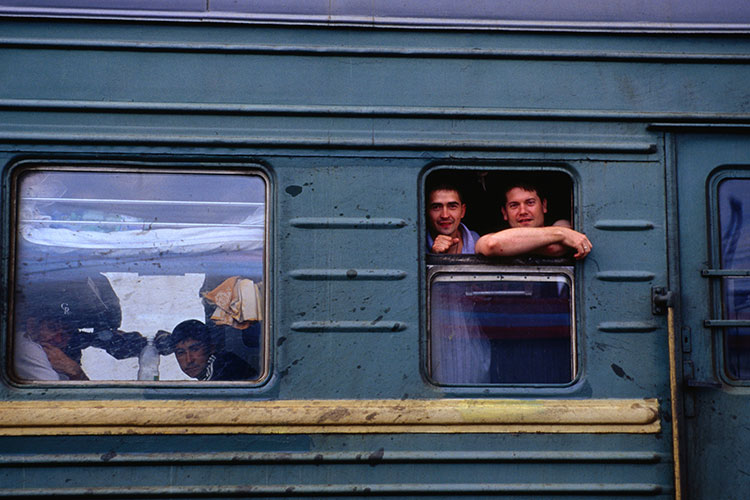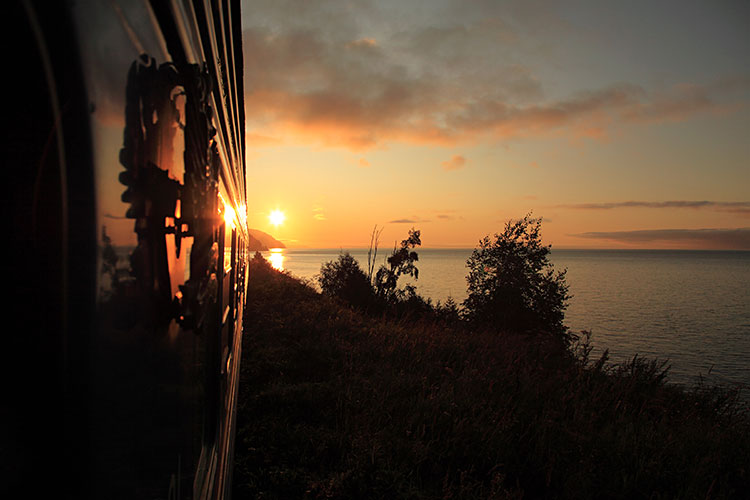Though it represents an incredible feat of engineering, it is Russia’s white elephant – hugely underused and costing the country billions of roubles, not to mention the price paid in blood and bones. The BAM runs parallel to the Trans-Siberian railway, but though it’s only 400km further north, it seems a world away: its towns and villages remain seemingly untouched by the rapid changes transforming the rest of the country, its passengers are predominantly locals, and foreign travellers are practically unknown.

A train travelling through the snow in Siberia. Image by Fursov Aleksey / Flickr / Getty Images.
The train carried me east through the night, towards Tynda, the ‘capital of the BAM’, a town 2364km east of Tayshet. After the interminable flat countryside of Western Russia, the scenery north of Lake Baikal was striking: craggy mountains topped with freshly fallen snow, wide rivers, and red-and-gold birch forests signalling the onset of autumn.
One the train I talked late into the night with Faya and Andrei, a married couple working as provodniks (carriage attendants). They were both university graduates but, with jobs being scarce, were forced to earn a living any way they could. 'Our son’s university has an exchange program in the States. I don’t want him to leave, but at the same time, when he graduates, what’s he going to do here?' Faya told me.

The emblem of Russian Railways. Image by Nick Laing / AWL Images / Getty Images.
One of my carriage neighbours was Svetlana, a retired BAM worker – one of the volunteers who’d helped build the BAM, lured to Tynda in the 1970s by a mix of genuine patriotism and triple pay. She missed the stability of the Communist era; she’d managed to save up to buy flats for her children and grandchildren and informed me life in Communist times was ‘like paradise’. With typical Siberian generosity, Svetlana plied me with homemade food and refused my offer of biscuits.
Tynda’s monolithic railway station was covered with enormous faded posters proclaiming the 35th anniversary of 'the road built with love'. The irony was not lost on me: while the railway was finished in the '70s and '80s by young Komsomol (Communist Youth League) members, the original work between the 1930s and 1950s was done by gulag inmates and Japanese prisoners of war. At least half a million of these prisoners were worked to death and their remains lie in unmarked graves along the BAM and its offshoot, the AYaM (Amuro-Yakutskaya Magistral), which connects the Trans-Siberian railway to Yakutsk via Tynda.
I took a train south along the AYaM, then east along the Trans-Siberian, then north again towards Komsomolsk-na-Amure, BAM’s other large town. The passengers were less smartly attired than those you find along the Trans-Sib, clad in simple clothing.
Alighting in Komsomolsk-na-Amure, I stepped into a time warp. The shabby, uniform apartment blocks lining the wide streets put me in mind of the Soviet Union of my childhood, circa the 1980s, and I understood why Siberians complained that the government doesn’t invest in this forgotten corner of a past empire. The only hint of change brought by capitalism was the 'U-City' pizza parlour, serving lukewarm slices to hip young people. I walked past some grandiose Soviet mosaics and found myself on the banks of the wide, slow-flowing Amur. The river port was utterly dead; the only people around were three fishermen standing motionlessly on the litter-strewn sandy beach.
As I walked around, I read the notices on the walls. One by a self-styled shaman called Vladimir invited readers to ‘training sessions’ to teach them to be ‘on the same wavelength with nature’ and make them ‘Healthier! Stronger! Richer!’ 'A sober Russia is the will of the people!' proclaimed another, belied by the sight of a group of men sitting in the main square, clutching 2L bottles of Baltika beer. The train station is scarred by scathing graffiti, hinting at political turbulence and discontent.

Passengers crossing Siberia on a Russian train. Image by Patrick Horton / Lonely Planet Images / Getty Images.
En route back to Tynda, my neighbours were two miners, Zhora and Vanya, travelling to work in the gold mines north of Tynda. Zhora’s been working along the BAM his whole adult life, but he dreamt of greater things: 'I want to bring ecotourism to the BAM; the fishing here is out of this world!' Then his spirits dropped as he pondered the obstacles: the antiquated bureaucracy, the bribes to secure fishing permits. A young miner with a scarred face, Zhenya, sidled up to us and offered us a large tub of red caviar, which we ate with spoons straight out of the pot while Vanya plied me with strong black tea.
They bombarded me with questions about the UK: How much does a miner earn in a year? How much is a loaf of bread? How cold does it get? These hardy folks, used to winter temperatures of -47C in winter and seven months of snow a year, were mightily amused to learn that the UK comes to a standstill following a snowfall of two inches. I was stumped by the question about different types of British soil; growing one’s own and self-sufficiency were topics I was ill-equipped to discuss.
Getting off in Tynda, I walked up the main drag – Krasnaya Presnya – lined with identical apartment buildings, passing a giant hammer-and-sickle at the crossroads and the ugly, plastic-looking Cathedral of the Holy Trinity. Inside the BAM History Museum (ul Sportivnaya 22), next to a replica barracks where BAM workers lived during the railway's construction, the middle-aged curator proudly talked me through the collection – from photos of those who built the railway to a 1980s telephone switchboard used for communication. She drew my attention to some Evenki reindeer herder artefacts – a wooden baby’s crib, a shaman's outfit, fur-lined hunting skis.

Lake Baikal at sunset seen from the railway line. Image by Image Source / Getty Images.
Living in the Lake Baikal area since the Neolithic era, the Evenki fared badly under Communism – forced settlement, loss of culture and language and a downward spiral into alcoholism is a common story. The situation was looking brighter near Novy Uoyan, also on the BAM. Back in Severobaikalsk, I talked to Aleksei who works with the Evenki community, arranging winter tours into the mountains with the reindeer: 'The head of the community has forbidden alcohol in the village and those men who’re inclined to drink on the sly are sent into the mountains to work with the reindeer. That way they’re busy and stay off the booze.'
Aleksei and his daughter Anya are part of the Great Baikal Trail Project (greatbaikaltrail.org). Every summer, local and foreign volunteers come to Lake Baikal, the oldest, deepest and largest lake on earth, signposting and improving its existing hiking trails. 'The original idea was to have a continuous trail that runs along the entire lakeshore, but we’ve come to realise that it’s impractical and are focusing on existing ancient trails, such as those used by the Evenks,' Anya told me.
Before boarding the train to Moscow, I took a walk along the clifftop path overlooking Baikal. There was no one around to spoil my appreciation of the steep slopes overgrown with pine, the birches changing colour, and the brooding, snow-tipped mountains in the distance, beyond the immense expanse of glass-like blue.